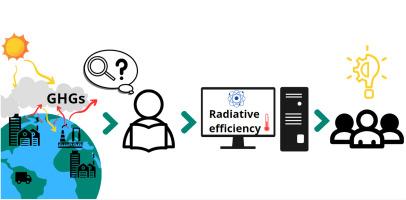In silico modelling of radiative efficiencies of anthropogenic greenhouse gases
IF 3.7
2区 环境科学与生态学
Q2 ENVIRONMENTAL SCIENCES
引用次数: 0
Abstract
Radiative efficiency (RE) is a climate metric adopted in international reports on climate change to quantify the greenhouse capacity of gases, and hence to guide decision-making processes and drive transitions in the production and utilization of chemicals in different application fields. Key quantities for the determination of the RE of a gas are the atmospheric irradiance profile and the infrared (IR) absorption cross section spectrum. The latter is usually measured experimentally, even though acquiring high-quality IR spectra can pose severe challenges, sometimes limiting the accuracy or the accessible spectral range. While computational quantum chemistry methods have emerged as valuable tools to simulate IR absorption properties, their application to REs estimation is still limited to the use of the double-harmonic approximation, which presents fundamental limitations. In this work, a cost-effective quantum chemical (QC) workflow including non-empirical anharmonic contributions to spectral properties and an automatic identification of conformer distribution is presented for the accurate evaluation of REs using a range of atmospheric irradiance profiles. Different levels of theory are considered, according to the current state-of-the-art, and the accuracy of the QC RE tool is demonstrated with reference to a number of representative halocarbons widely used in refrigeration, manufacturing, and pharmaceutical fields. The results show that REs can be computed with an average accuracy of 5% using double-hybrid functionals, which overshoot the widely used B3LYP method. Finally, the QC methodology is applied to determine the REs of selected halocarbons for which data is limited, or to address some contradictory results appeared in the literature for some species. The outcomes of this work demonstrate that QC anharmonic IR cross section spectra can be used to estimate REs with an accuracy on par with that of experimental measurements, hence applicable to challenging cases for providing data for policymakers as well for screening purposes when seeking new replacement compounds.

人为温室气体辐射效率的硅学建模
辐射效率(RE)是气候变化国际报告中采用的一种气候指标,用于量化气体的温室效应能力,从而指导决策过程,推动不同应用领域化学品生产和利用的转型。确定气体 RE 的关键量是大气辐照度曲线和红外线(IR)吸收截面光谱。后者通常是通过实验测量的,尽管获取高质量的红外光谱会带来严峻的挑战,有时会限制精确度或可获取的光谱范围。虽然计算量子化学方法已成为模拟红外吸收特性的重要工具,但其在 REs 估算中的应用仍局限于使用双谐波近似,这带来了根本性的限制。在这项工作中,介绍了一种经济有效的量子化学(QC)工作流程,其中包括对光谱特性的非经验非谐波贡献和构象分布的自动识别,以便利用一系列大气辐照度剖面准确评估 REs。根据当前最先进的理论,考虑了不同的理论水平,并参考了广泛应用于制冷、制造和制药领域的一些具有代表性的卤化碳,展示了 QC RE 工具的准确性。结果表明,使用双杂交函数计算 REs 的平均准确度为 5%,超过了广泛使用的 B3LYP 方法。最后,QC 方法被用于确定数据有限的某些卤化碳的 REs,或解决文献中出现的某些物种的矛盾结果。这项工作的成果表明,QC 非谐波红外截面光谱可用于估算 REs,其精确度与实验测量结果相当,因此适用于具有挑战性的情况,为决策者提供数据,并在寻找新的替代化合物时用于筛选目的。
本文章由计算机程序翻译,如有差异,请以英文原文为准。
求助全文
约1分钟内获得全文
求助全文
来源期刊

Atmospheric Environment
环境科学-环境科学
CiteScore
9.40
自引率
8.00%
发文量
458
审稿时长
53 days
期刊介绍:
Atmospheric Environment has an open access mirror journal Atmospheric Environment: X, sharing the same aims and scope, editorial team, submission system and rigorous peer review.
Atmospheric Environment is the international journal for scientists in different disciplines related to atmospheric composition and its impacts. The journal publishes scientific articles with atmospheric relevance of emissions and depositions of gaseous and particulate compounds, chemical processes and physical effects in the atmosphere, as well as impacts of the changing atmospheric composition on human health, air quality, climate change, and ecosystems.
 求助内容:
求助内容: 应助结果提醒方式:
应助结果提醒方式:


